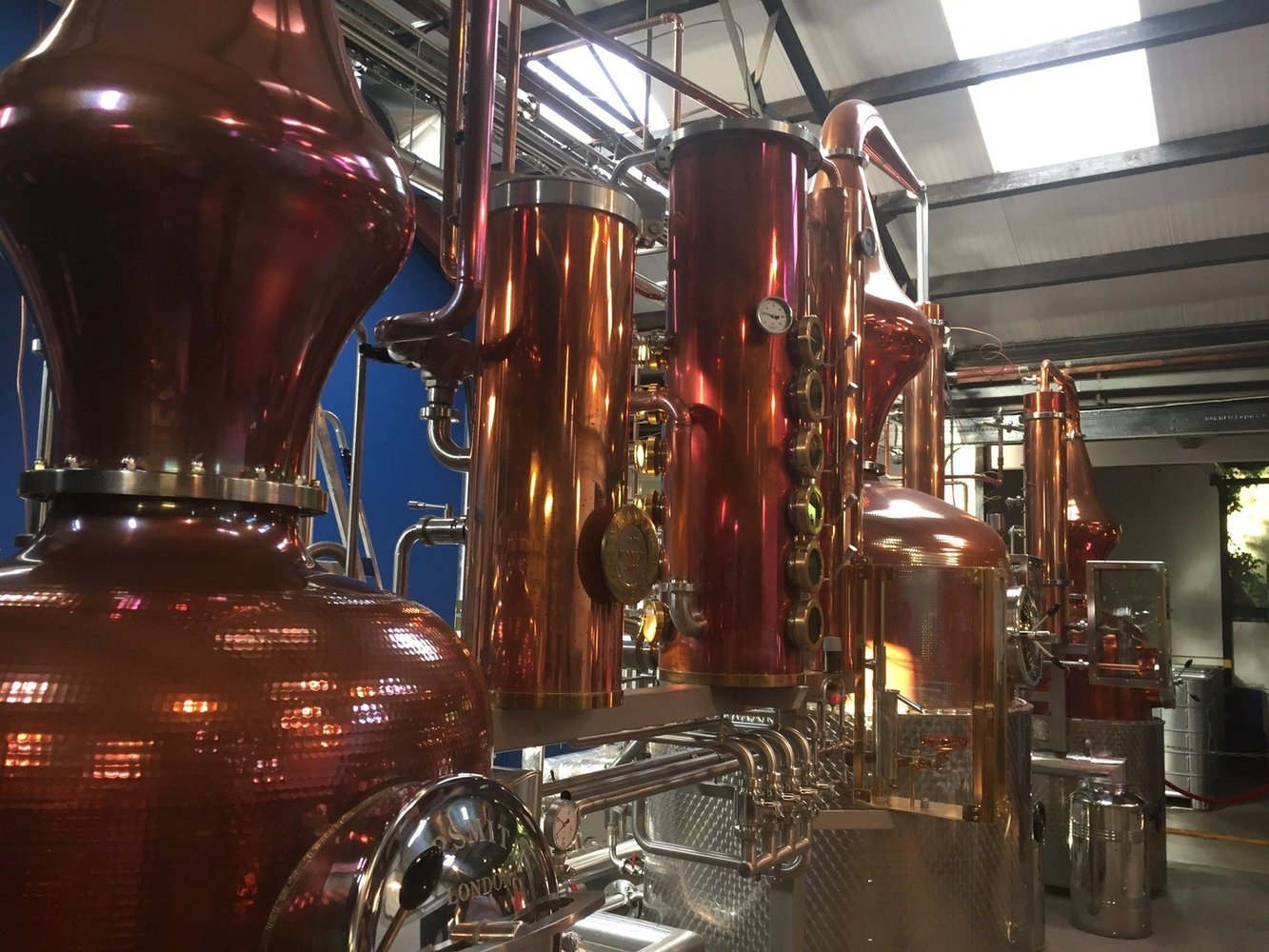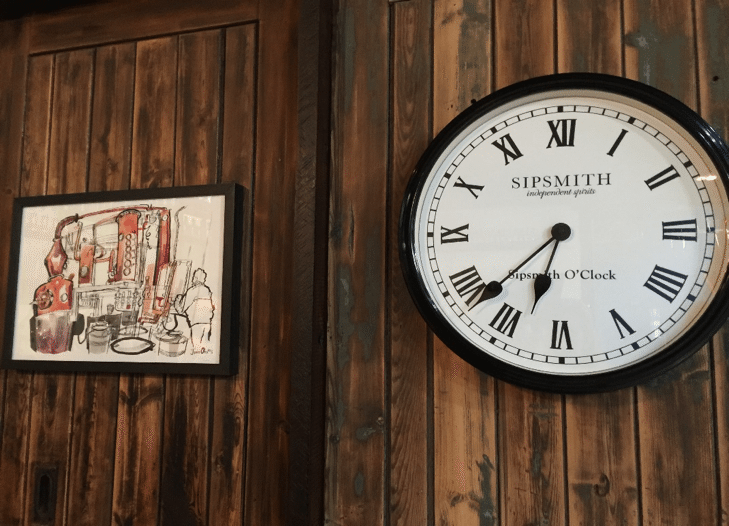
A couple of days ago, Matthew and I went to the Sipsmith Distillery in Chiswick, where we live, for a lovely two-hour tour, history lesson and tasting. Dear reader, we went for you and this is our report. It’s a rotten job but someone has to do it.
Inside the distillery
It turns out that Sipsmith is right in the heart of a residential neighbourhood here in Chiswick. From the outside it looks like a slightly run-down factory out of an Ealing comedy. Terry Thomas or Ian Carmichael might appear at any moment.

Inside, though, it’s another story. Imagine a tipsy Willy Wonka had an unlimited copper budget. There are three big, shiny stills – more on them later – and a mad scientist corner with test tubes and samples and its own small, experimental still. On the other side, there’s a fully-functioning bar with samples and a wall lined with experimental gins.
In short, Sipsmith is your tipsy, millionaire uncle’s garden shed. Absolutely charming.
What, exactly, is gin?
Gin is basically a flavoured spirit with juniper as the main element. Besides juniper, gin is flavoured by other ‘botanicals’ such as coriander seeds, citrus peel, angelica, orris root and many others.
The base spirit can come from a variety of sources, but the top gins use at least 96% abv strength grain spirit, which is diluted with pure water to get to a drinkable abv of ~40%

Types of gin
There are two main types of quality gins. (I am excluding the ones where artificial oils and flavours are added to the base spirit. Avoid them.)
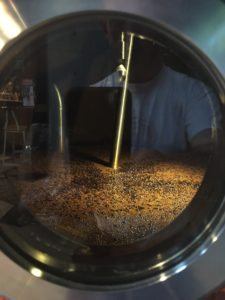
- London Gin. The neutral base spirit is macerated with juniper and other botanicals and redistilled in a pot still. No other flavours are permitted after distillation. Adding a bit of sugar is permitted, but if the producer doesn’t do that, the gin can be called London Dry Gin and it is mentioned on the label. Famous brands include: Beefeater, Gordon’s, Bombay, Tanqueray and the lovely Sipsmith.
- Distilled gin. This is a gin produced using the same method as London Gin, with the caveat that the producer can add other botanicals after the distillation. Usually this is the method preferred for gins flavoured with cucumber or rose petals, as they are too delicate to go through the distillation process. Hendrick’s is an example of cucumber-flavoured gin which I love with a bit of cucumber skin and black peppercorns in the glass instead of lemon peel.
A brief history of gin
Gin first troubled history goes back in the 17th century in Holland, where it was produced as a medicine and sold in chemist shops to cure stomach complaints, gout and gallstones. To make it more palatable, the Dutch started to flavour it with juniper and began to call jenever after the berry.
So, if you ever worry about drinking gin, don’t: it’s medicinal.

Since Matthew’s ancestors were Dutch pharmacists in the very early 18th century, we’re going to claim a family connection there.
During the 30 Years War in the Low countries, the English observed that the Dutch were given rations of this drink, which made them braver in battle, hence the insult about ‘Dutch Courage’. The English tried it too, liked it and began importing it.
During the war with the French, William of Orange, the king of England observed that French were using their taxes on alcohol production to fund the war. He decided to follow suit with gin in the vanguard. He made it very easy to get a distillery licence and very quickly sales of gin exceeded sales of beer and ale.
Apparently a pint and a half a day was the average consumption. So if you’re worried that you drink too much, don’t! You’re a complete lightweight compared to your ancestors.
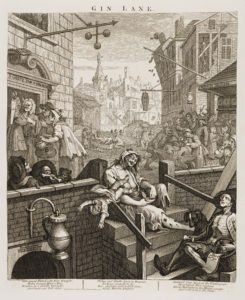
Enter the gin and tonic
The first gin and tonic dates back to 1850. It was an anti-malarial for British troops serving in India. Tonic water contains quinine and the gin and lemon made the medicine more palatable.
People quickly made the health-conscious decision that prevention was better than cure and start drinking G&T all the time.
Since then its popularity has ebbed and flowed and it has only recently started to make a comeback as a fashionable cocktail ingredient and, indeed, as a sipping drink in its own right thanks to changes in the licensing laws that allowed new boutique and artisanal distilleries to brew up.
The Sipsmith story
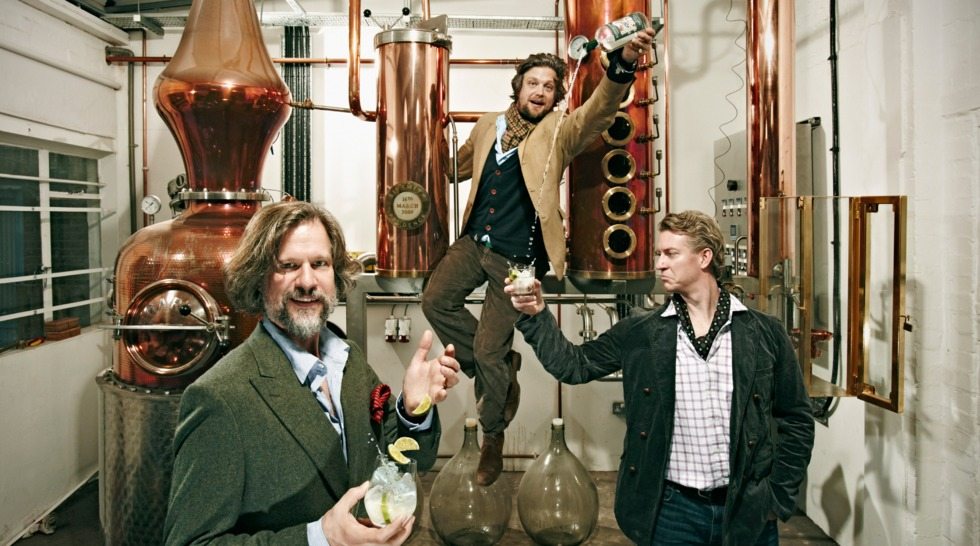
Sipsmith’s roots go back to 2009 when a team of gin aficionados started a quest to bring gin of uncompromising quality and character back to the city where it all began. They invested their assets into two gorgeous copper stills (named Constance and Prudence), made by Cristian Carl, a German craftsman and founded Sipsmith in 2014; the first new copper still in London for almost 200 years. Since then, they have added another still, named Patience. All three greet you, like three swans on a lake, when you enter the distillery. The copper and steel fittings make you feel like you’re looking at some kind of steam punk space station or something out of Jules Verne.
Distilled memories
Seeing the three copper stills made me very nostalgic. I went back in time and remembered childhood memories, when I used to visit my grandparents with my cousins, in a small Romanian village.
In those Communist-era days, my grandfather had four precious things that nobody was allowed to touch: his bicycle, his radio, his flashlight and his copper still, made by a gipsy craftsman. In the heat of August, us kids, would pick up juicy plums, store them in open containers, where they would ferment for a couple of weeks. Then at the beginning of September, the distillation could begin.
My grandfather was always doing it during the night, as it was kind of illegal. This was the most exciting activity of the summer for us, the kids. This is when I learnt the concept of ‘heads’, ‘hearts’ and ‘tails’ first hand.
Tails are for communists
The heads are the first thing that comes out of distillation. People usually throw them away. My grandfather was more interested in the hearts, tasting it from time to time to see when the output of the still changed to tails, which is more watery.
He used to say: ‘the middle is for me, the heads and the tails are for the Communist party’, which he distilled again to get it drinkable. I still remember putting my finger through the output and tasting the warm plum rakia (~ 40% abv) with my cousins, when he was not looking. No wonder we were all so full of energy and happiness. Ahhh, happy memories!
He used to store the hearts, which is the best bit, into traditional vessels and put them in the root cellar. And each year, a strange phenomenon occurred! Gradually, over time, all the rakia would evaporate. It was usually all gone by Easter, to the deep frustration of my grandmother, who had to throw lunches for the village Communist party leaders, to keep them off their back. Pfhiu!!! The heads and tails! He knew what he was talking about.
Sipsmith distillation
Coming back to Sipsmith and their beautiful stills, they use Prudence to make both gin and vodka (for gin, they skip some steps). They start with 96% wheat-based spirit, then water it down to a 60% abv alcoholic wash, which they infuse with botanicals boil at ~80°C (alcohol boils at 78.3°C, while water boils at 100°C).
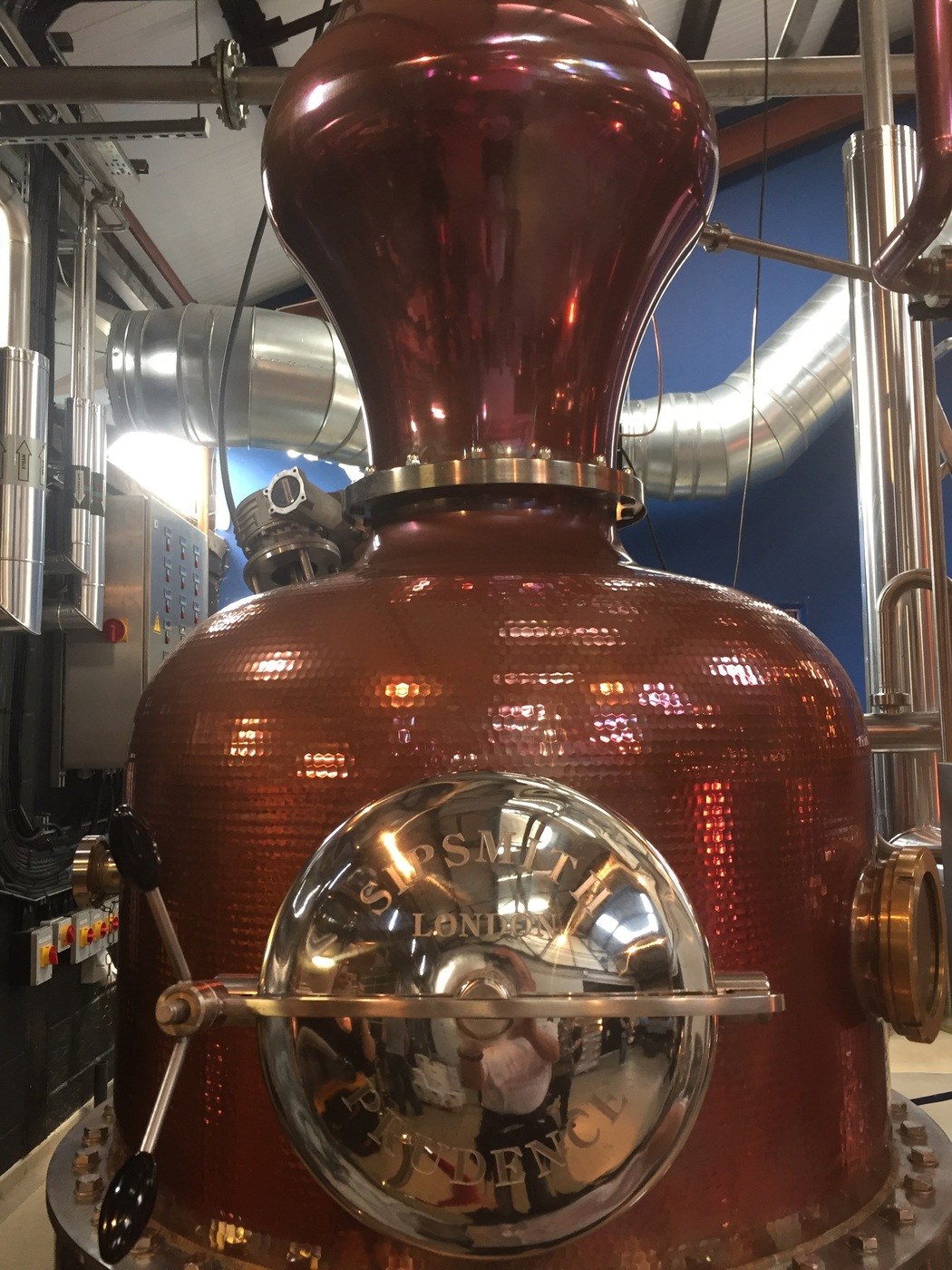
The reason they use copper stills is that copper expands with heat and absorbs heavy elements and impurities. Copper makes for a purer, smoother taste compared with high-volume distilleries that use stainless steel. Of course, they scrape and clean their copper stills from time to time, to ensure a pure output. Sipsmith recycles the heads and the tails into cleaning products.
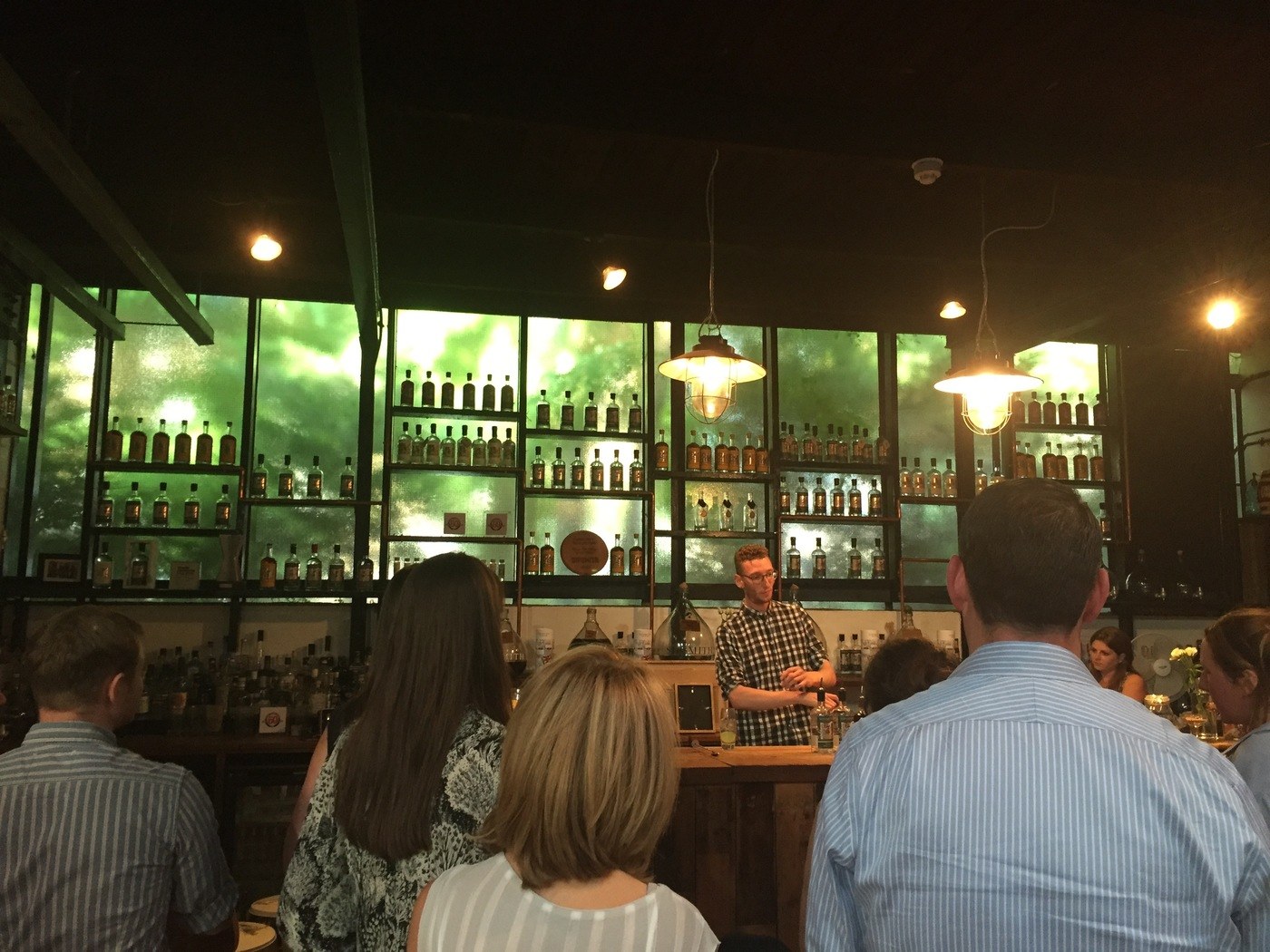
For the London Gin, you can add sugar, water and more alcohol, but Sipsmith choses to add only water. Larger distilleries tend to make distil gins with very concentrated flavours – too rich to drink – and then dilute them with added alcohol, like watering down a super-boozy cordial, but Sipsmith prefer a gentler, subtler approach to flavour with just enough botanicals to flavour the gin without dilution.
Sipsmith range
Their range includes gins and vodkas. My two favourites are the London Dry Gin and their Sloe Gin.
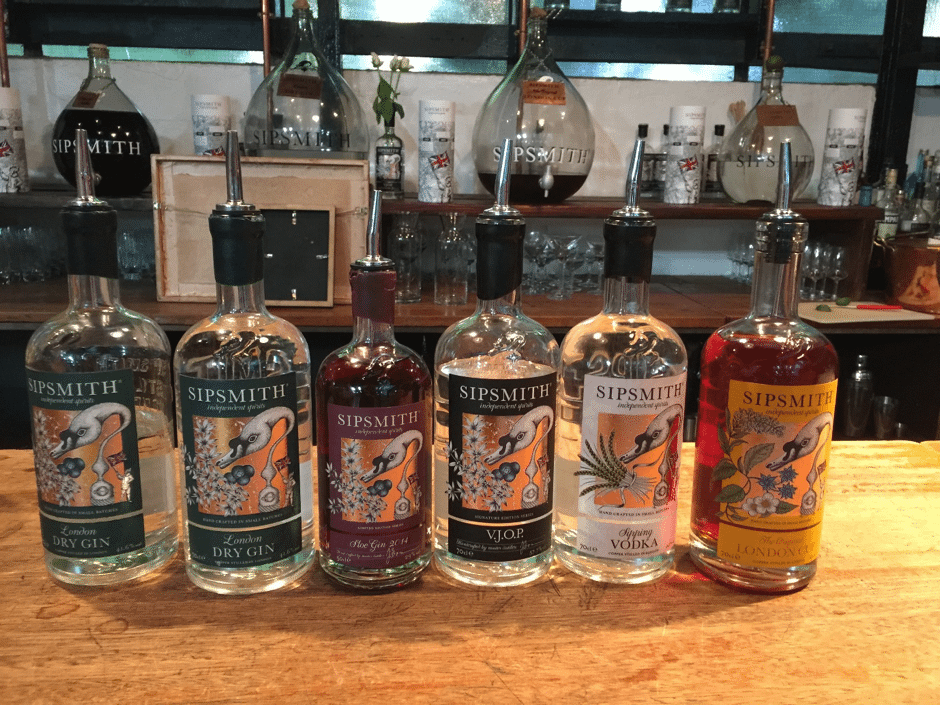
I am not very keen on their new thing (personal preference, don’t shoot the messenger), with which they greeted us. Matthew liked it and if you like punches such as Sangria or Pimms, then you’ll like this.
Tips for the perfect G&T
First of all, use a large-bowled red wine glass. This way, you make sure you don’t warm up the glass surface with your hand. Fill it as much as you can with ice; more is better because it is less likely to melt and dilute the drink. I use a Star Wars Death Star ice ball (one advantage of having a geeky boyfriend).
Use the proportion on one-third gin two-thirds tonic water or even 50:50 if you want it more charged up. For London Dry Gin, I would only use a slice of lime as garnish, twisted slightly to release the volatile aromas. Garnishes are for the nose, not for the taste. Go for Fevertree tonic water. It’s Sipsmith’s recommendation and ours too.
If you want a new flavour gin, add peppercorn, cucumber peel, basil or orange peel. Experimentation – and lots of it – helps. It’s your G&T and you need to find your favourite recipe.
Visiting Sipsmith yourself
We loved our visit. It’s a superb experience and a great way to learn more about gin. You can book online at their website and the £25 price includes samples and a nice drink on arrival.

